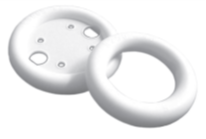Treatments for SUI
The majority of women living with the urinary symptoms of stress incontinence can be treated successfully and resume a full and active lifestyle. Treatment options range from lifestyle changes and pelvic floor physical therapy to medical devices and minimally invasive surgical procedures designed to stop urinary leakage and restore quality of life.
First Line Treatments
Lifestyle Changes
Incorporating these lifestyle changes may help reduce your urinary symptoms:
- Fluid and diet management including minimizing fluid intake and avoiding bladder irritants such as caffeine and spicy foods
- Maintaining a healthy weight to help eliminate excess pressure on your bladder
- Quitting smoking
- Absorbent continence pads to provide added protection from urine leakage
- Keeping your bladder empty by urinating every 2 to 3 hours
Pelvic Floor Physical Therapy
Pelvic floor physical therapy strengthens the pelvic floor and sphincter muscles that help support the bladder.
Pelvic floor exercises can help prevent urine leakage by strengthening the pelvic floor and sphincter muscles. A specialized physical therapist can teach effective pelvic floor muscle exercises (Kegels) to help improve your symptoms. As with any new exercise program, it may take several months to strengthen the pelvic floor muscles and to see results.
Vaginal Pessary
 A vaginal pessary is a soft silicone device that, when inserted, provides
extra support for the urethra to prevent urine leakage. Pessaries come
in different shapes and sizes. Your provider will fit you for the correct
pessary and teach you how to insert and remove it. Pessaries are a good
option for women who wish to avoid surgery. Some women use a pessary only
during physical activity and others leave them in all the time. The device
offers flexibility to meet your needs.
A vaginal pessary is a soft silicone device that, when inserted, provides
extra support for the urethra to prevent urine leakage. Pessaries come
in different shapes and sizes. Your provider will fit you for the correct
pessary and teach you how to insert and remove it. Pessaries are a good
option for women who wish to avoid surgery. Some women use a pessary only
during physical activity and others leave them in all the time. The device
offers flexibility to meet your needs.
Minimally Invasive Surgical Treatments for SUI
Urethral Bulking
Urethral bulking involves the injection of a special material (such as a safe and natural hydrogel called Bulkamid®) around the urethra. The bulking agent is injected into the urethral opening to build up the thickness of the urethral wall. The bulking agent supports the bladder and forms a tight seal to prevent urine leakage.
The minimally invasive procedure is typically performed in your urologist’s office and takes about 15 minutes. You may be given local anesthesia to minimize any discomfort. Bulking agents such as Bulkamid are low risk and typically provide immediate and long-term symptom improvement and return to normal daily activities immediately after the treatment. Bulking agents may need to be repeated in several years.
Learn more about Bulkamid® Hydrogel Treatment here.
Surgical Treatments
Surgery for stress urinary incontinence is typically very successful in women who haven’t had success with other therapies. These procedures include:
Urethral Sling
Urethral slings are a common and effective surgical treatment option for SUI. Your doctor will perform a minimally invasive procedure to place a sling, a small piece of synthetic mesh, under the urethra. The sling forms a hammock of support for your urethra, keeping it supported to eliminate accidental urine leakage.
Placement of the urethral sling is done as an outpatient procedure and only requires a small incision in the vagina. You can expect to go home a few hours after the procedure. Most women do not experience major pain or discomfort after the placement. You can return to light activity four to six weeks post-surgery; however, you should avoid heavy lifting, sexual intercourse, and rigorous exercise for four to six weeks following your procedure.
Autologous Pubo-Vaginal Sling
An alternative to the more common mesh urethral sling, the autologous pubovaginal sling utilizes your own tissue, taken from the thigh or lower pelvic area, to create the sling. Because your doctor uses your tissue, there is no reaction to synthetic materials. The procedure, which is a more invasive, intricate surgery than a urethral sling, involves a small vaginal incision as well as two small incisions made above the pubic bone to insert and place the sling. A small incision in either the thigh or lower pelvis is also made to harvest the tissue.
Retropubic Suspension Surgery (Burch Procedure)
In some women, the bladder neck and urethra have dropped into the pelvic area, which causes involuntary urine leakage. Retropubic suspension surgery is a less common procedure that treats SUI by lifting the sagging bladder neck and urethra by attaching the bladder to structures behind the pubic bone to provide added support. This procedure is typically performed under general anesthesia either laparoscopically through several small incisions in the abdomen or via open surgery.
